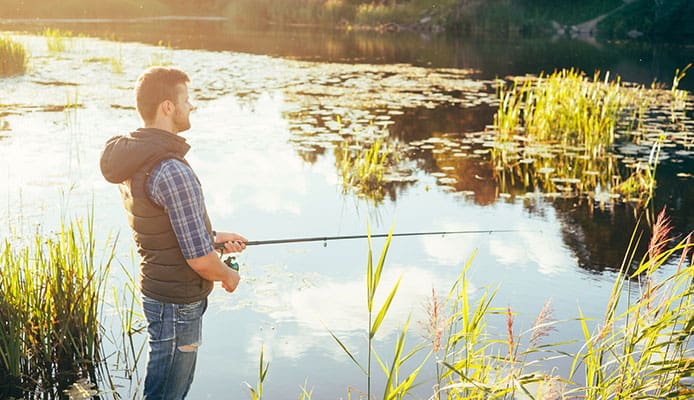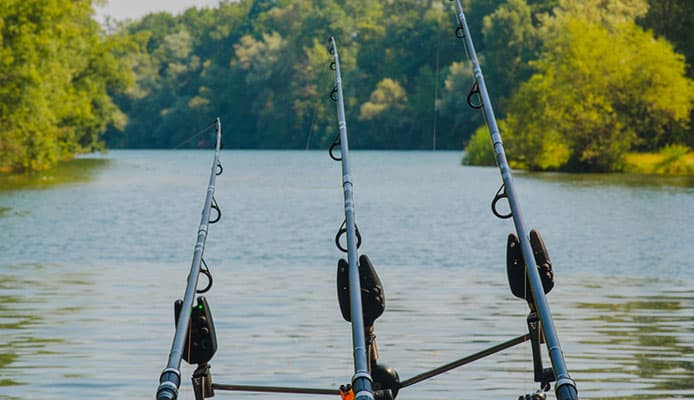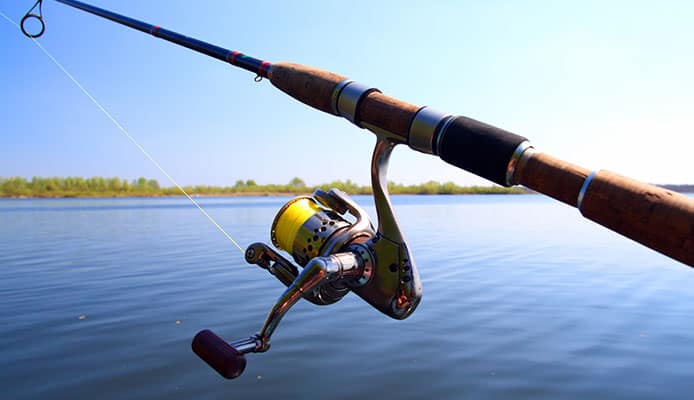
There are many reasons why spin fishing poles are the most popular. The best spinning rods are versatile, easy to master and use, simple to cast, and active and fun to fish with. They can be used for both freshwater and saltwater fishing for trout, salmon, perch, bream, pike, walleye, bass, and more.
If you’re just getting into fishing, spinning rods will make your learning curve easier and more enjoyable. They are also the go-to for finesse fishing, as they efficiently and accurately cast light lures and lines farther away.
With the spinning reel seat and line guides hanging underneath the rod, a spin fishing setup is well-balanced and comfortable to fish with even on day-long angling excursions. You’re also able to hold the rod in your dominant hand, which enhances the control you have when throwing lures and bringing in fish.
Whether your specialty is finesse fishing or you’re a beginner in the sport of fishing, a top quality spinning rod that suits your fishing style and target species is the most important piece of equipment.
To make it easy for you to find the best spinning rod for your needs and for the money, we’ve reviewed the top spinning fishing poles and explained what you need to look for when choosing a spinning pole. First of all, here are the best spinning rods when it comes to quality, performance, and value.
Ready to get started? Let’s go.
OUR TOP PICK
Ugly Stik GX2 Spinning
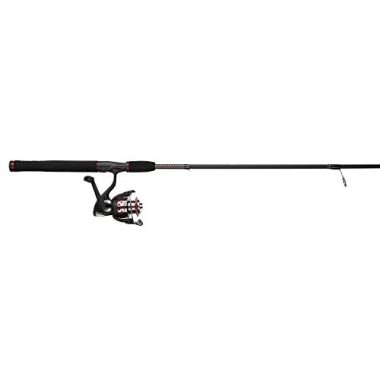
- Stand Out Features - Why We Love It
- A complete spinning rod and reel setup ready to use
- Durable, lightweight and sensitive hybrid composite rod construction
- A variety of length and power options to choose from
- Firm, lightweight and comfortable EVA grips
- Smooth reel casts great and retrieves fast
- Fantastic price and value
EDITORS CHOICE
Abu Garcia Ike Dude
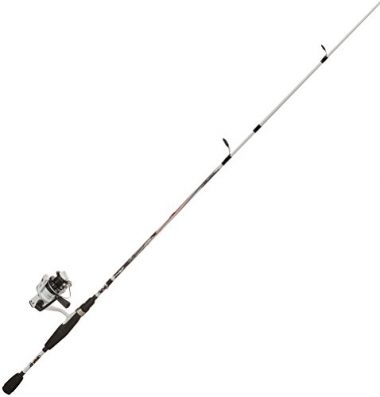
- Stand Out Features - Why We Love It
- The spinning rod already has a well-balanced reel attached
- It comes pre-spooled with fishing line
- Comfortable EVA grips reduce hand fatigue
- Features a Texas rigged hook keeper
- Cool looking fishing pole for young anglers
- Lightweight and easy to use
- Sturdy and well-built rod
- Great performance, great price, and great value
- Versatile for all types of freshwater fish
BEST VALUE
Shakespeare Micro
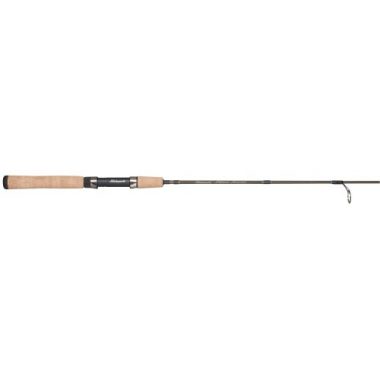
- Stand Out Features - Why We Love It
- Ultralight and light rod powers with a variety of length options
- Durable construction
- Lightweight and comfortable to use
- Well balanced and nice action
Shimano Solora 2 Piece
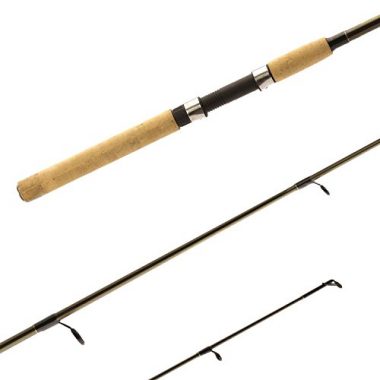
- Stand Out Features - Why We Love It
- Durable construction
- Backed by a one year limited warranty
- Comfortable and easy to use handle
- Great quality at a friendly price
- Breaks down for portability and is easy to re-assemble
- Fast action with a variety of lengths
Cadence Fishing CR5
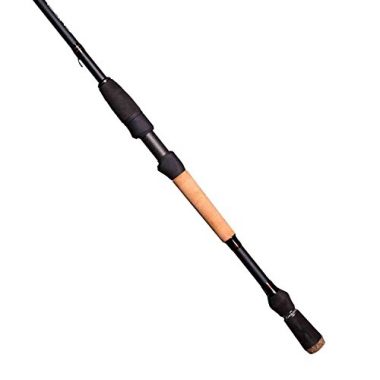
- Stand Out Features - Why We Love It
- Excellent quality and durable construction
- Top quality and durable guides and reel seats
- High quality and ergonomic handles
- Features SIC guides and Fuji grip components
- Great fit and finish
- Exceptional rod, value and customer service
- Lightweight and well-balanced
- Available in 16 different lengths, actions and power combinations
Entsport Sirius 2-Piece
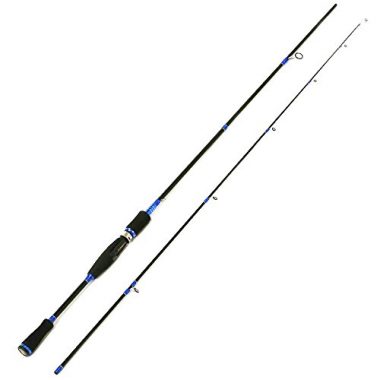
- Stand Out Features - Why We Love It
- Good quality, durable construction, and attractive finishing
- It features a hook keeper
- Saltwater and freshwater use suitability
- Portable two-piece construction
- Versatile with medium powers and length
- Lightweight and comfortable to use
- It comes well-packaged in a protective bag
- Backed by excellent customer support
St. Croix Mojo Inshore
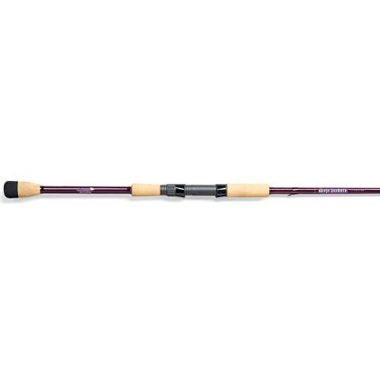
- Stand Out Features - Why We Love It
- Stylish looking fishing pole
- Premium quality fishing rod
- Equipped for saltwater inshore fishing
- Lightweight, well-balanced and sensitive
- Strong and durable construction
- Premium and anti-corrosive components
Falcon Rods Coastal

- Stand Out Features - Why We Love It
- Features 100% Fuji guides for smooth line flow
- Lightweight yet strong and durable construction
- Ergonomic cork handle offers a firm and comfortable grip
- Resilient for saltwater use
- Optimized for inshore fishing
- Flexible and sensitive
Berkley Inshore
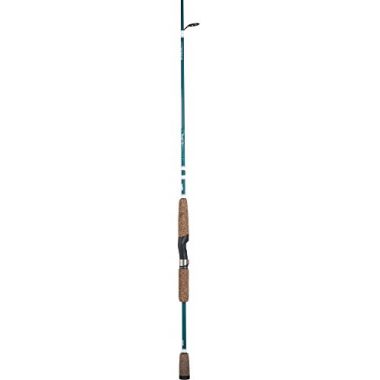
- Stand Out Features - Why We Love It
- Lightweight and ergonomic pole
- Optimized for inshore anglers
- Durable and corrosion resistant
- Versatile medium powers
- Comfortable soft rubberized cork grip
- Great flexibility and sensitivity
Daiwa Exceler
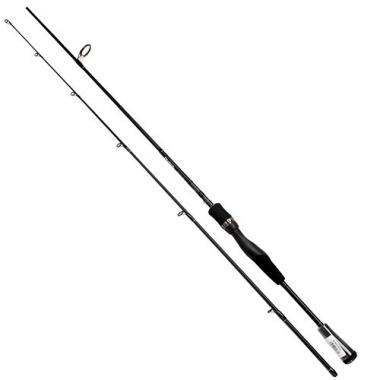
- Stand Out Features - Why We Love It
- Comfortable and well-balanced
- Two-piece design offers ease of portability
- Lightweight and very sensitive
- Well-made, strong and durable
- Great casting and action
How To Choose The Best Spinning Rod – Buying Guide
Your goal when choosing a spinning rod is to find and buy a top quality spinning pole with the right combination of action, power, length, and other features for your type and style of fishing. Such a spin fishing pole will offer you reliable and smooth performance for a good number of years giving you great value for your money.
The first step towards finding the spinning rod you need and want is to determine what kind of fishing you’ll be doing. What type of fish will you be pursuing? Where will you be fishing? What fishing line pound test and lure weights will you be using?
Are you looking for a saltwater spinning rod, a freshwater spinning rod, a spinning rod for bass? An ultra-light spin fishing pole for small baitfish or a medium spinning rod that will suit a wide range of fishing situations? By taking this simple step, finding the best spinning rod for your needs becomes easier.
Next, assess the features that affect rod performance – power, action, length, material, line and lure weight rating, handle, construction – on any spinning rod you’re considering. Here is an explanation of the characteristics to pay attention to when choosing a spinning pole:
Length
Spinning rods come in different lengths. The length of a spinning rod determines the kind of control you have when casting or fighting fish and the casting distance you can achieve with it. To determine the ideal length to get, consider how far you’ll need to cast, where you’ll be casting from and the type of bait you’ll be using.
Longer rods have a faster tip speed, which enables them to cast farther and cover a wider area of water. They also absorb the shock when fighting bigger fish preventing the line from breaking. If you’ll be surf fishing, fishing in large and open water bodies, going after larger fish or using bigger baits, you need a long length spinning pole.
Shorter spinning rods give you more accuracy and control when casting but only cast short to medium distances. They also offer more leverage and maneuverability where there’s heavy vegetation. If you’ll be fishing from a boat or kayak, casting small to medium lures, or precision is what you want, go for a short length pole.
Weight
A rod’s weight indicates its strength and how much weight its tip can sustain without snapping. There are ultralight, light, medium light, medium, medium heavy, heavy, and extra heavy weight rods. The right weight depends on the line and lure weights, size of fish, and type of fishing you’ll be doing.
If you’ll be going after large, heavy fish, casting high pound-test lines, heavier lure weights, going offshore trolling, surf fishing, deep-sea fishing, or hauling fish from thick, heavy cover, what you need is a heavy weight rod with the power to handle these heavy fishing tasks.
Fishing in clear, open water, casting lighter lines and baits, and fighting small fish like panfish call for ultra-light or light rod weights. These are highly responsive and designed to handle 2-6 pound line and 1/32-ounce lure weights.
Medium weight rods are versatile and can handle a wide range of small to larger fish sizes, line and lure weights, and light to moderate cover.
Catching small bait fish on a heavy rod is no fun and the rod can cause the lighter line to snap. Fighting a large fish using a light rod requires superior rod handling skills and can be a lot of fun if successful but the most likely outcome is a broken rod.
Durability and comfort are also considerations here. Heavier rods are more tiring but have more strength and durability. You can comfortably fish all day with ultra-light and light rods but they tend to break easily being light and thin.
Action
Action describes how a spinning rod bends when there is a load at its tip; where it bends and how quickly it recovers when the weight is removed. It affects how a spinning rod casts and the types of fishing situations it handles best. There are extra fast, fast, medium, and slow action rods.
Extra fast action spinning rods are the stiffest and bend just at the tip while fast-action rods bend in the top third of the blank. They are very sensitive and transmit even the slightest of bites and strikes. They store a lot of power at the tip and cast long distances. They also produce quick hooksets. They are popular for jigging and trolling.
Medium action rods bend in the top half of the rod towards the middle. They have a reasonable amount of sensitivity, flex, and backbone to set hooks well and prevent treble hooks from pulling out. They work well for casting mid-weight crankbaits and lighter lures farther away.
You might also be interested in:
Slow action rods bend uniformly throughout the rod length acquiring a parabolic curve. They are the most flexible and are great for ultralight fishing of small baitfish because they absorb the shock preventing the light rod and line from snapping. They produce gentler hooksets, as they set hooks slower, and are the best for fishing with delicate and live baits.
Blank materials
The blank dictates the feel, performance, durability, and ease of use of a spinning pole. Spinning rods are designed for fishing with smaller baits and lures and their blanks should be lightweight and sensitive yet strong enough to be able to fight fish without snapping and also last longer. This is why the majority of spinning rods feature graphite blanks.
Graphite or carbon fiber has a high strength-to-weight ratio and makes for blanks that excel in strength, durability, flexibility, and sensitivity. They are also lightweight and comfortable to use. Their weakness is that they tend to be brittle and require more care, especially when getting them out of car doors.
If you’re going after larger and heavier fish and are an experienced angler and don’t need that much sensitivity, you may prefer blanks made out of fiberglass. They are stronger, heavier, more durable and more affordable than graphite blanks but aren’t as sensitive.
For blanks that offer the best of both graphite and fiberglass while minimizing their weaknesses, composite blank construction uses a combination of graphite and fiberglass to produce rods that are lightweight, strong, powerful, and sensitive.
Type
If you need a travel-friendly spinning rod, there are two types of rods you can go for. 2-piece spinning rods break down into two short sections making them easier to transport to and from your fishing destinations.
Telescopic rods are designed to collapse into compact, packable lengths that are very easy to pack and transport in your fishing backpack. They can go from 20-30 foot long when extended to as little as one to two feet long when collapsed.
One piece rods can be cumbersome to transport but their continuous construction offers the best responsiveness and performance when fishing.
Saltwater spinning rods are made saltwater tough with strong, durable and corrosion resistant construction and components to withstand the corrosive and abrasive abuse they’re subjected to and be able to handle the larger, heavier and more aggressive saltwater fish.
Freshwater spinning rods are strong and lightweight consistent with the smaller freshwater fish species and the smaller and lighter lures and lines required to catch them.
Surf rods designed for use with spinning reels when shore fishing are long with long grip handles for two-handed casting. The longer lengths allow them to cast the lure or bait long distances and also provide the strength to cast heavy lures or baits in rough water.
Durability
You definitely want a nice quality and high-performance spinning rod that will serve you for a long time giving you value for your money. Don’t forget to assess the rods you’re considering for durability by checking their construction, components, and power.
When it comes to the best rod blank material for durability, fiberglass is the winner. Graphite is also strong and durable but tends to be brittle.
The quality of the components on a spinning rod also affect its durability. Pay attention to the quality of the reel seat and line guides. Make sure the reel lock-down is metal or has metal reinforcement and fits snugly when tightened. Top quality line guides include ceramic guides for their wear and corrosion resistance, Fuji’s concept guides, and silicon carbon (SIC) inserts.
A rod’s power indicates the strength it has. Heavy power rods are strong and durable while light rods tend to break easily especially if used to cast heavier lines or lures, fight aggressive fish or haul fish from thick cover.
If you’ll be using your spinning rod for saltwater fishing<span style=”font-weight: 400;”>, ensure that you choose saltwater spinning rods that are made strong and equipped with corrosion resistant finishes and components. Using your freshwater spinning rod in saltwater is a sure way to shorten its lifespan.
Its also important to use your rod properly and take good care of it to enhance durability. Even a top quality and well-built rod with lasting properties will break if used for heavier fishing tasks than it can handle or handled carelessly. And when properly cared for, less-expensive spinning rods can last a long time in good condition.
Grip
The grip the handle on a spinning rod provides determines the control and leverage you have over the rod. The handle should feel good in your hand and be comfortable to hold for as long as you choose to fish.
Cork and EVA foam are the top handle materials. They’re soft, comfortable to grip and offer a great feel. EVA foam resists stains better while Cork handles look great and tend to conform to the shape of your hand for a better grip.
Ergonomically designed grips that minimize hand fatigue during extended fishing excursions are ideal. Split- grips in front and behind the reel seat offer a secure grip when handling hard-fighting fish, as you can wrap a finger or two around the reel seat.
Ensure that the handle is the right length for your fishing style. When fishing from a fishing kayak, a short handle is better because of the limited range of motion. A larger and longer handle provides plenty of space for the right grip for longer casts or two-handed casting.
FAQs
Q: How Do I Calculate The Action Of The Rod?
The action of the rod refers to the way the rod bends when placed under load. As for how to calculate it, action isn’t a precise measurement. It’s a general observation as to where most of the rod’s bend falls.
It’s classified as extra fast, fast, medium and slow. To determine the action of a rod, observe what percentage of the rod from the tip bends when pressure is applied at the tip.
An extra fast action will bend only at the tip. A fast action rod will bend in the top third or less. A moderate or medium action rod will bend in the top half from the tip down to its mid-section. A slow action rod will bend uniformly throughout its length right through to the butt.
You can also determine the test curve of the rod, which is a guide to the rod’s power and action. The test curve refers to the minimum weight it takes for the rod to acquire a 90 degrees bend.
You can find out the test curve of a rod by clamping it by its handle several feet above the ground in a horizontal position. Thread fishing line through the rings and attach a load close to the tip ring. Gradually increase the weight of the load until the rod bends at 90 degrees.
You can also use a spring balance to determine the minimum load it takes to bend the rod through 90 degrees but be careful as the risk of injuring yourself with this approach is high.
Q: What Is Better: Heavier Or Lighter Rod?
Whether a heavier or lighter rod is better depends on where you will be fishing, the type of fishing you’ll be doing, the size of fish you’ll be going after and the weight of line and lures you’ll be using.
A heavier rod is better for throwing heavy lures and higher pound tests line, bringing in large, heavy fish, hauling fish in from heavy cover as well as for surf fishing, deep sea fishing, and offshore trolling.
A lighter rod is better when catching small bait fish like panfish, bream, and crappie using smaller lures and lighter lines and fishing in clear, open water. Ultra-light rods are designed for throwing 2-6 pound test lines and lures weighing from 1/32-ounce.
Related Reviews: Surf Fishing Rod & Crappie RodsQ: How Do I Clean and Store My Fishing Spinning Rod?
To ensure your spinning rod stays in good condition and functions properly on your next fishing adventure, it’s important to keep it clean, dry, oiled and store it properly. This is especially important after saltwater use and when you’re going to be storing it for a long period of time. Here’s how top keep your valuable spinning rod in tiptop condition:
How To Clean Your Fishing Spinning Rod
- After every fishing excursion, the most important thing to do is rinse your spinning rod with fresh water. This will get salt, sand, and loose dirt off your rod and prevent it from embedding deep into the nooks and crannies on your rod. Use a gentle mist when rinsing as a powerful spray could force particles into the crevices.
- Wash the entire rod with warm soapy water and a soft cloth or soft-bristle brush and a mild, friendly cleaner to remove stubborn dirt. Never use harsh cleaning items and substances that could damage your fishing rod such as a steel brush, gasoline or bleach.
- Wash all components gently but thoroughly. Clean the grips. Wipe down the male ferrules and use a Q-tip to remove dirt and grit from the female ferrules. Clean the guides and replace any that are damaged.
- Rinse your rod gently and let it dry completely. Lightly spray or wipe the rod with a lubricating protectant to preserve its finish. Apply a light reel grease on rod guides to prevent corrosion. For 2pcs spinning rods, use a little candle wax to rub the joints where the sections come together to prevent friction.
How to Store Your Fishing Spinning Rod
Once your rod is clean, dry and oiled, the next step is to store it properly to protect it from damaging elements and prevent curvatures from developing.
The best way to store your spin fishing rod is to put it in a sleeve or cover then store it in a case mounted vertically or horizontally out of harm’s way.
Do not store your rod by leaning it on a wall or a corner, as this might weaken and bend it. Keeping it in a rod tube is also a bad idea, as humidity can cause moisture to damage your rod.
Never leave your fishing spinning rod in your car, boat, or truck where it is exposed to extreme heat or cold or lay it over something hard where it will bounce, as this will weaken it.
Globo Surf Overview
Spin fishing is a preferred method of fishing for many anglers targeting trout, salmon, perch, bream, pike, walleye, bass, and more. Having the right rod for the job makes the experience productive and fun. The best spinning rods are strong and durable yet lightweight and sensitive, feel good in your hand, and offer reliable and smooth performance.
Your best spinning rod is one that offers the right configuration of action, power, length, composition, and construction for where you’ll be fishing, the type of fish you’ll pursuing, and the type of line and lures you’ll be using. Such a spinning rod will deliver the kind of performance you want without failing you. If you’re looking for a travel-friendly pole that’s easier to transport, the best 2 piece spinning rods break down into more packable lengths.
With the right spinning rod for your style of fishing, all you have to do is match it with the right spinning reel<span style=”font-weight: 400;”>, add fishing line, select the best lures for your target fish and you’re ready to hit the water and have a successful and enjoyable spin fishing excursion!
More Fishing Rods Reviews:
- Catfish Rods
- Surf Fishing Rods
- Crappie Rods
- Saltwater Fishing Rods
- Kids Fishing Poles
- Crankbait Rods
- Jigging Rods
- Telescoping Fishing Rods
- Dropshot Rods
- Jerkbait Rods
- Baitcasting Rods
- Spinning Rods
- Fly Fishing Rods
- Fishing Rod And Reel
- Bass Fishing Rods
More Rod Reviews:
Do you enjoy spin fishing? Have you used any of the above spinning rods? What was your experience? Share with us in the comment box below



